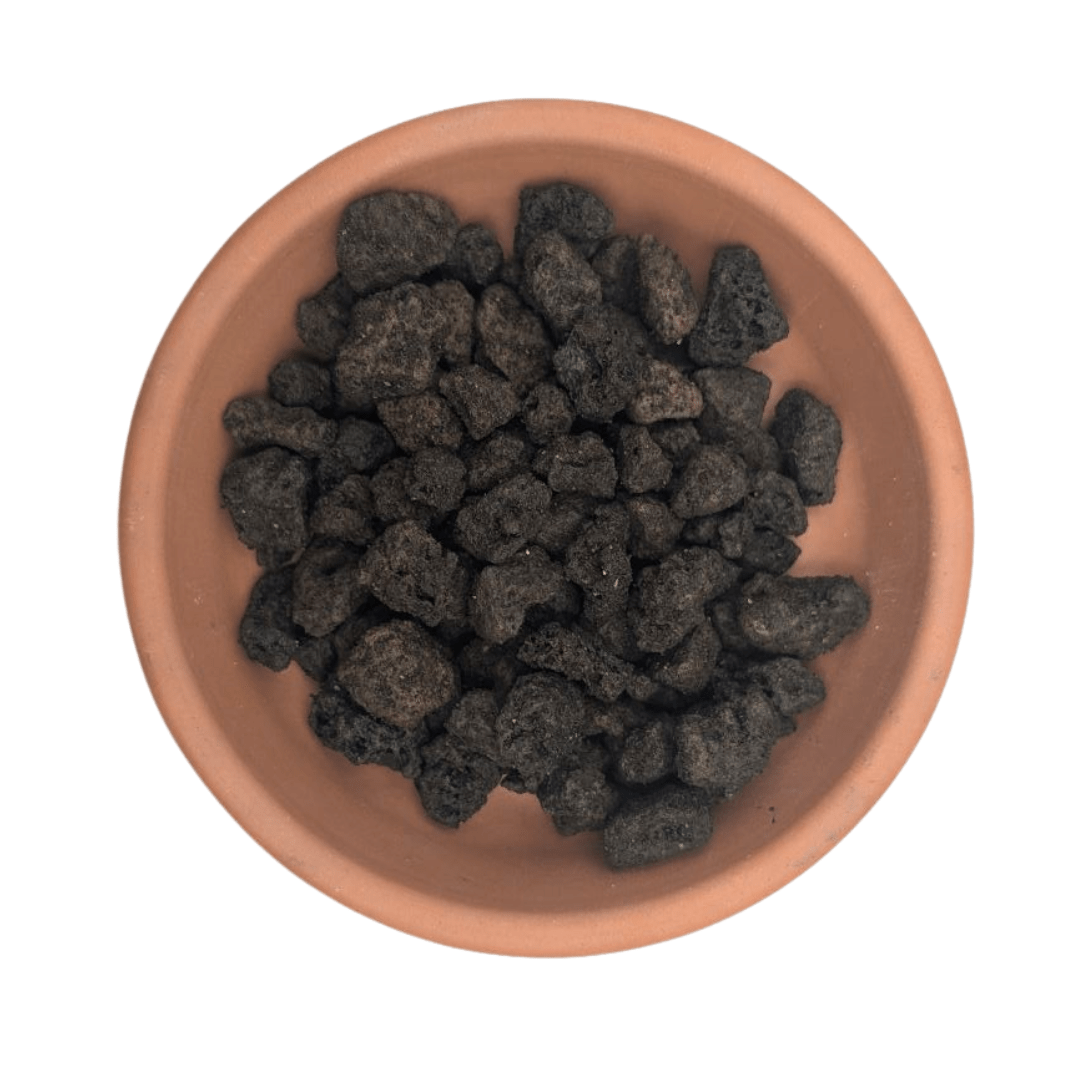Black Scoria 5-10mm is a naturally occurring, highly porous volcanic rock ideal for gardeners and plant enthusiasts aiming to enhance soil structure and promote robust root development.
Formed from rapidly cooled lava, this eco-friendly medium improves aeration, drainage, and nutrient retention. It's particularly suited for a variety of plants, including cacti, succulents, bonsai, and orchids, supporting optimal growth across diverse horticultural applications.
Features
High Porosity – Provides a large surface area that ensures excellent aeration, crucial for healthy root growth.
Nutrient Storage – Acts as a reservoir for essential nutrients, making them readily available to your plants.
Superior Drainage – Promotes effective water drainage while retaining necessary moisture, preventing waterlogging.
Durable and Long-Lasting – Unlike perlite, Black Scoria resists crushing, maintaining its structure in no-till environments.
Versatile Use – Perfect for various plants, including cacti, bonsai, succulents, and orchids. Suitable for aroid soil mixes and as a chunky additive in orchid bark mixes.
Aesthetic Appeal – The dark hue of Black Scoria adds a striking contrast to your plant arrangements, enhancing visual appeal.
Why You Should Buy
Black Scoria is not only functional but also environmentally conscious. Unlike other soil amendments that require energy-intensive processing, Black Scoria is a sustainable choice. Its durability means fewer replacements, offering a cost-effective solution for gardeners. Whether you're potting a bonsai or creating an aroid mix, this versatile substrate enhances every blend, promoting healthier plants and more vibrant displays.
FAQs
What is Black Scoria, exactly?
A naturally porous volcanic rock. The 5–10mm grade is chunky enough to boost drainage and airflow while still holding a touch of moisture and nutrients.
Why use Black Scoria for cacti, succulents, and bonsai?
Those plants hate soggy feet. Scoria creates air gaps, speeds up drainage, and encourages dense, healthy root growth.
What size is Black Scoria?
It’s screened to 5–10mm—ideal as a chunky additive in mixes or as a clean, modern-looking top-dress.
Is Black Scoria pH neutral?
Yep. It won’t meaningfully shift your mix’s pH in normal use.
Do I need to rinse Black Scoria before use?
Quick rinse = less dust = cleaner pot and better airflow. Not mandatory, just neat and tidy.
Will dust from scoria cause issues if I don’t rinse?
Fine dust can clog pores and slow drainage. If you’re mixing into soil, a fast rinse or sieve is worth the minute it takes.
How much should I add to my mix?
Start with 10–30% of total volume for general aeration. Go lean (~10–15%) for thirstier plants; go heavier (~25–30%) for desert types or if your climate is humid.
Can I use it 100% straight, with no soil?
Not recommended for long-term growth. Plants still want some fines/organic fraction for nutrients and stable moisture. Use scoria as the structure; add a small amount of quality mix or fines.
Is Black Scoria different from red scoria or “lava rock”?
Color aside, they’re functionally similar. Both are vesicular volcanic rock (often called lava rock). Choose black if you prefer the clean, dark aesthetic or want stronger contrast with plant colors.
Scoria vs pumice—what’s the practical difference?
Pumice is lighter and may hold a bit more water; scoria is denser, tougher, and typically cheaper. Many growers mix the two, but you don’t have to—scoria alone still improves structure and drainage.
Will Black Scoria break down or compact?
Very slowly. Unlike perlite, scoria resists crushing and keeps its structure through many seasons.
Is Black Scoria reusable?
Yes. Tip old mix onto a tarp, pick or wash out roots, give it a scrub/rinse, and reuse.
How do I sterilise reused scoria?
Rinse well, then either soak in hot water, bake on a tray at low oven temps (watch for moisture/steam), or use a dilute hydrogen peroxide soak. Let it dry before re-potting.
Does Black Scoria add nutrients?
It’s mostly inert. The pores hold onto nutrients from your fertiliser schedule rather than “feeding” the plant by itself.
Will Black Scoria stain my hands, benches or pots?
It can shed a little dark dust when dry—rinse first and you’re good.
Is the 5–10mm grade okay for orchids and aroids?
Yep—as a chunky additive in orchid bark mixes or aroid blends where you want extra airflow.
What about carnivorous plants?
Usually not ideal—those mixes prefer very low nutrients and different textures. Stick to their standard peat/sand/perlite type recipes.
Can I top-dress with Black Scoria?
Absolutely. It looks slick, prevents soil splashing, reduces algae crusting, and discourages fungus gnats from laying eggs on the surface.
Will Black Scoria heat up in full sun and cook roots?
Top surfaces can warm up, but with normal pot depth and a typical soil blend, roots are fine. If you’re worried in extreme heat, shade the pot and water earlier in the day.
Does Black Scoria float like perlite?
No. It’s heavier and stays put during watering.
Can I use Black Scoria in hydroponics or semi-hydro (LECA-style)?
You can. It’s inert and porous. Just be aware the irregular shape isn’t as uniform as LECA balls, and it’s heavier. Rinse well before use.
What mix recipe do you recommend for succulents?
Easy starter: 1 part potting mix, 1 part scoria, 1 part coarse sand or pumice. Tweak to your climate—more scoria in humid areas, less in dry, windy spots.
What about bonsai?
Common approach: equal parts akadama (or quality clay granules), scoria, and pumice. If you don’t have akadama, pair scoria with pumice and a small amount of quality inorganic fines.
How much water does Black Scoria hold?
Just enough in its pores to buffer between waterings, but not so much that roots sit wet. That’s the point.
Will Black Scoria alter drainage holes or mesh screens?
5–10mm doesn’t slip through typical bonsai mesh or pot screens. If your pot has large cut-outs, lay down mesh or a larger base layer.
Is Black Scoria safe for indoor plants?
Yes—just rinse first to keep dust down and avoid tracking.
Any quirks when repotting?
Scoria’s rough edges grip roots nicely, which helps anchor plants. Use a chopstick to work it in and eliminate air pockets.
Can I combine Black Scoria with coco, compost, or worm castings?
Totally. Scoria provides structure; organics provide nutrients and moisture retention. Keep organics moderate for cacti/succulents.
Will Black Scoria encourage fungus gnats?
Top-dressing with scoria actually helps deter them by keeping the surface drier and less inviting.
How many pots will a 5L bag cover?
As a top-dress: roughly 8–12 small (10–12cm) pots, or 3–5 medium (15–20cm) pots. As a mix component, coverage depends on your recipe—expect ~1–2 medium repots per 5L when using 20–30% scoria.
Does Black Scoria work in raised beds or outdoor planters?
Yes. Blend in to open up heavy mixes and improve drainage, especially in waterlogged spots.
Will black scoria fade?
It may lighten slightly as dust washes off and surfaces weather, but the core color stays dark.
Can I crush Black Scoria smaller?
You can, but it’s messy and you’ll create a lot of fines. If you need a finer grade, sieve out the smallest bits after a rinse or source a smaller size.
Is Black Scoria safe around pets and kids?
It’s just rock. Edges can be sharp—don’t use where barefoot traffic is common, and keep away from curious chewers.
Any shipping or pickup notes?
Available in 5L and 10L. Click & Collect is usually ready fast; packaged cleanly to keep dust contained.
Quick start guide—how do I use Black Scoria today?
Rinse → mix 10–30% into your potting blend (or use as a top-dress) → water through to settle → enjoy better drainage and happier roots.


